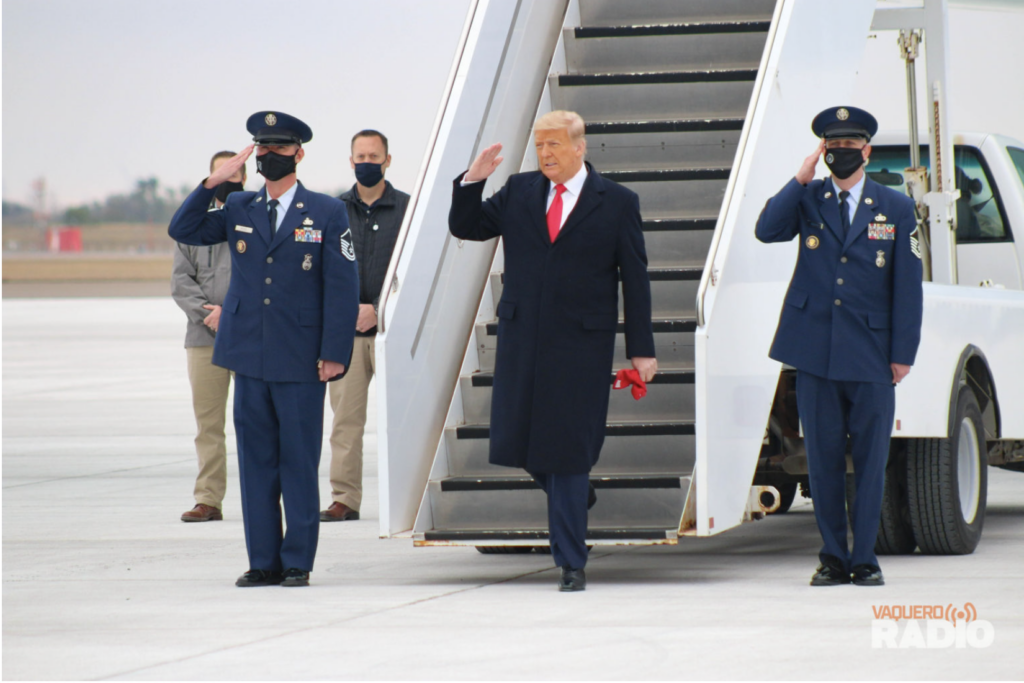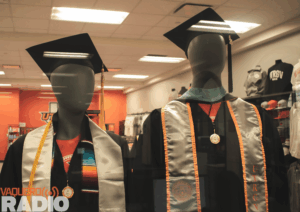
JUSTIN ELIZALDE/VAQUERO RADIO PHOTOS
After surviving two assassination attempts, two impeachments, a failed effort to overturn the 2020 election, and legal challenges, Donald Trump will return to the political stage as the 47th president of the United States.
Trump’s victory was largely driven by his economic policies, which resonated with voters struggling with the standard of living under the Biden-Harris administration. His focus on tax cuts, immigration and a pro-business approach led voters to believe these elements would boost economic growth and job creation.
But some voters were skeptical of Trump’s policies, believing his 2017 Tax Cuts and Jobs Act disproportionately benefited the wealthy, while failing to ease the financial burden on the middle and lower classes.
UTRGV political science Professor Clyde Barrow said the tax cuts Trump imposed only benefited the top 1% of the wealthiest Americans, which totaled a $1.5 trillion tax cut.
“Did that cause the economy to grow?” Barrow said. “No, it doesn’t because billionaires just collect it and sit on it. They buy stocks and bonds, but it doesn’t create any real economic growth. So, it’s a redistribution of wealth from the bottom to the top. It really doesn’t benefit the economy in any significant way.”
Gary Groves, a member of the Hidalgo County GOP, argues the concept behind tax cuts is to give consumers more disposable income. Groves said during Trump’s previous tax cuts, government revenue from taxes actually increased despite lower tax rates. This happened because a thriving economy and increased consumer spending boosted overall economic activity.
“The theory there is give money to people to create jobs and to spend money rather than the government taking the money from people and spending it on things that, you know, are not always productive, such as wars,” he said.
Groves emphasized lowering taxes puts more money into the hands of Americans and corporations, helping to create jobs and stimulate the economy.
“Lowering taxes is giving money to the American people, to the corporations to create more jobs,” he said. “More money came in when they cut taxes, again, because it stimulates the economy. And putting money in the hands of consumers and corporations creates more money, adds jobs, versus taking it away with a government that, you know, tends to waste it on wars, and giving it to other countries, and spending it on projects that many times don’t help anything.”
Trump has proposed lowering the corporate tax rate from 21% to 15% for companies that manufacture products in the U.S., according to the Committee for a Responsible Federal Budget. Diego Escobari, Ph.D. program director and economics professor in the Robert C. Vackar College of Business and Entrepreneurship, said large firms with stocks will benefit by keeping the money instead of paying taxes.
“This is typically money that corporations use to buy back their stocks,” Escobari said. “So, this is going to typically push their stock prices up. Broadly speaking, if you think about firms and if you see lower taxes, you would keep your fingers crossed as a consumer and say, ‘Hey, if this firm is paying lower taxes, I would like to see lower prices, right, on the products that they are producing.’”
Whether companies lower prices depends on the industry’s competitiveness. He said that in highly competitive industries, prices may drop, but in less competitive ones, prices are unlikely to change.
“Lower corporate taxes may not go to consumers, but those typically will go to higher stock prices,” Escobari said. “Or, hopefully, if it’s not final consumers that will see lower prices, the hope would also go to, let’s say, firms coming up with investments, right. If these firms [are] paying less taxes, hopefully, the additional amount of money they have, they can reinvest it, and this will hopefully, like, move the economy.”
Voter dissatisfaction with inflation was a key issue in the recent election. While Trump has pledged to reduce inflation, his proposed trade taxes may contradict that goal. The Tax Foundation reports that the president-elect plans tariffs of 10% to 20% on all imports, 60% on Chinese imports and 25% to 100% on Mexican imports.
Javier Villarreal, communications director for the Hidalgo County Young Democrats, expressed concern that if Trump proceeds with his tariff policy, it could leave citizens struggling to make ends meet.
“Because people are not able to meet the cost of living, they’re going to be asking the government for food stamps or other resources,” Villarreal said. “And at the end of the day, either he’s going to have to provide to his constituents or he’s going to say no.”
Groves said tariffs are in place because other countries have been imposing tariffs on American goods. This led U.S. companies to move production overseas to bypass those tariffs.
“Foreign companies will have to come here to produce goods,” he said. “Our companies don’t have to go over there to produce goods. And we are an open playing field. So, it would create more competition. [At] the end of the day, less inflation.”
Barrow said if Trump follows through, it could return America to 1950s tariff policies, where the National Bureau of Economic Research said states with high tariffs faced price distortions and low economic performance after the 1950s.
“And just [to] give you one simple example, Walmart imports from 60 [%] to 80% of everything it sells from China,” he said. “So if you impose a 60% tariff on China, you can immediately expect whatever shoes, clothes or anything else you buy at Walmart to increase from anywhere to 40 [%] to 60%.”
Another controversial policy from Trump’s administration was his plan for the mass deportation of millions of people who entered the country illegally. As of 2022, unauthorized immigrants made up 3.3% of the U.S. population, according to the Pew Research Center. Despite their undocumented status, these individuals contributed $96.7 billion in federal, state and local taxes in 2022, based on data from the Institute on Taxation and Economic Policy.
Barrow highlighted that attempting to deport all immigrants could strain the economy, leading to labor shortages, increased inflation and a significant decline in their contributions to federal, state and local budgets.
“When there’s a shortage of anything the price goes up,” he said. “So, you layer on all of these policies, should Trump actually succeed in implementing each one of these policies. Each one is going to add another layer of inflationary pressures to the economy.”
Villarreal recalled reading in his economics textbook that undocumented labor makes up a significant portion of the U.S. economy. He added that deporting immigrants would leave job vacancies in farming and field industries that Americans are unwilling to fill.
“For the United States to take away that percentage of the population that is undocumented and working in the United States for the minimum wage, if you take away those those folks, you’re going to make either the economy crash or going to a crisis, because, again, the people from the United States are not willing to take those jobs,” Villarreal said.
Groves said individuals here illegally cannot earn fair wages since they are outside the formal job market, often resulting in underpayment. He said it seems that Trump’s policies aim to prioritize better pay for American workers.
While the specifics of mass deportations remain unclear, Groves said cutting off benefits for those not legally working might encourage them to leave voluntarily, which could help shift the focus back to lawful immigration, allowing individuals to participate in the workforce on equal terms.
“Because people take advantage of the illegal immigrants,” he said. “And I think we all know it living here. They pay them, you know, under the table, they pay them less. And that hurts our workers who are from the [Rio Grande] Valley who are trying to work, and, you know, get ahead. And so with President Trump’s economic policies, they should get better wages.”
The Center for Migration Studies of New York reported 8.3 million immigrants work in industries such as construction, landscaping, agriculture, and food processing. Barrow explained Trump’s deportation agenda could force businesses reliant on this labor to shut down.
“One is you produce less, which means gross domestic product grows at a slower rate,” he said. “Or you close down plants. And we’ve seen that happen in many examples where ICE has raided, like, meat processing plants and poultry plants. And when they do that, those plants end up closing down permanently because they can’t find anybody to do those jobs.”
Groves highlighted supporting President Trump feels like backing a historic achievement, especially considering his win in the counties of Cameron, Hidalgo, Starr, Zapata, Webb, Maverick, Kinney and Val Verde. Whether Democrat or Republican, Americans share the common goal of a thriving economy and prosperity for everyone.
When Trump says he is for the American people, that resonates with him. Over time, Groves said it feels like the government has shifted to serving special interests rather than the people.
He said the government passes bills filled with provisions the public is not even aware of. Groves remembers a time when legislation was debated openly, allowing Americans to have a say. Sadly, he said, it seems the U.S. lost that transparency and involvement.
“And so if he can bring back, you know, government for the American people, and where we participate, and it’s for us, not for, you know, corporations or overseas interests, but it’s all about the American people,” Groves said. “And that would be a major change in the way our government is right now. And that would be a beautiful thing if he can bring that about.”



